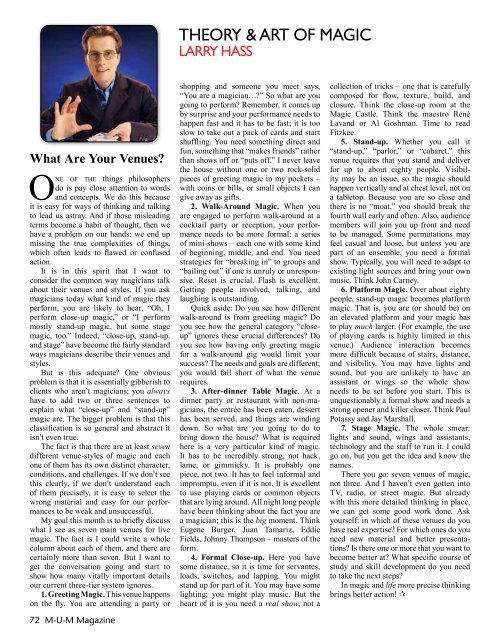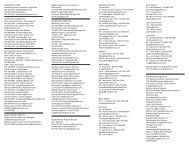(Hank) Moorehouse 1934 – 2011 - The Society of American Magicians
(Hank) Moorehouse 1934 – 2011 - The Society of American Magicians
(Hank) Moorehouse 1934 – 2011 - The Society of American Magicians
You also want an ePaper? Increase the reach of your titles
YUMPU automatically turns print PDFs into web optimized ePapers that Google loves.
What are your venues?<br />
one oF <strong>The</strong> things philosophers<br />
do is pay close attention to words<br />
and concepts. We do this because<br />
it is easy for ways <strong>of</strong> thinking and talking<br />
to lead us astray. And if those misleading<br />
terms become a habit <strong>of</strong> thought, then we<br />
have a problem on our hands: we end up<br />
missing the true complexities <strong>of</strong> things,<br />
which <strong>of</strong>ten leads to flawed or confused<br />
action.<br />
It is in this spirit that I want to<br />
consider the common way magicians talk<br />
about their venues and styles. If you ask<br />
magicians today what kind <strong>of</strong> magic they<br />
perform, you are likely to hear, “Oh, I<br />
perform close-up magic,” or “I perform<br />
mostly stand-up magic, but some stage<br />
magic, too.” Indeed, “close-up, stand-up,<br />
and stage” have become the fairly standard<br />
ways magicians describe their venues and<br />
styles.<br />
But is this adequate? One obvious<br />
problem is that it is essentially gibberish to<br />
clients who aren’t magicians; you always<br />
have to add two or three sentences to<br />
explain what “close-up” and “stand-up”<br />
magic are. <strong>The</strong> bigger problem is that this<br />
classification is so general and abstract it<br />
isn’t even true.<br />
<strong>The</strong> fact is that there are at least seven<br />
different venue-styles <strong>of</strong> magic and each<br />
one <strong>of</strong> them has its own distinct character,<br />
conditions, and challenges. If we don’t see<br />
this clearly, if we don’t understand each<br />
<strong>of</strong> them precisely, it is easy to select the<br />
wrong material and easy for our performances<br />
to be weak and unsuccessful.<br />
My goal this month is to briefly discuss<br />
what I see as seven main venues for live<br />
magic. <strong>The</strong> fact is I could write a whole<br />
column about each <strong>of</strong> them, and there are<br />
certainly more than seven. But I want to<br />
get the conversation going and start to<br />
show how many vitally important details<br />
our current three-tier system ignores.<br />
1. greeting magic. This venue happens<br />
on the fly. You are attending a party or<br />
72 M-U-M Magazine<br />
THEORY & ART OF MAGIC<br />
LARRY HASS<br />
shopping and someone you meet says,<br />
“You are a magician…?” So what are you<br />
going to perform? Remember, it comes up<br />
by surprise and your performance needs to<br />
happen fast and it has to be fast; it is too<br />
slow to take out a pack <strong>of</strong> cards and start<br />
shuffling. You need something direct and<br />
fun, something that “makes friends” rather<br />
than shows <strong>of</strong>f or “puts <strong>of</strong>f.” I never leave<br />
the house without one or two rock-solid<br />
pieces <strong>of</strong> greeting magic in my pockets <strong>–</strong><br />
with coins or bills, or small objects I can<br />
give away as gifts.<br />
2. Walk-around magic. When you<br />
are engaged to perform walk-around at a<br />
cocktail party or reception, your performance<br />
needs to be more formal: a series<br />
<strong>of</strong> mini-shows <strong>–</strong> each one with some kind<br />
<strong>of</strong> beginning, middle, and end. You need<br />
strategies for “breaking in” to groups and<br />
“bailing out” if one is unruly or unresponsive.<br />
Reset is crucial. Flash is excellent.<br />
Getting people involved, talking, and<br />
laughing is outstanding.<br />
Quick aside: Do you see how different<br />
walk-around is from greeting magic? Do<br />
you see how the general category “closeup”<br />
ignores these crucial differences? Do<br />
you see how having only greeting magic<br />
for a walk-around gig would limit your<br />
success? <strong>The</strong> needs and goals are different;<br />
you would fall short <strong>of</strong> what the venue<br />
requires.<br />
3. after-dinner table magic. At a<br />
dinner party or restaurant with non-magicians,<br />
the entrée has been eaten, dessert<br />
has been served, and things are winding<br />
down. So what are you going to do to<br />
bring down the house? What is required<br />
here is a very particular kind <strong>of</strong> magic.<br />
It has to be incredibly strong, not hack,<br />
lame, or gimmicky. It is probably one<br />
piece, not two. It has to feel informal and<br />
impromptu, even if it is not. It is excellent<br />
to use playing cards or common objects<br />
that are lying around. All night long people<br />
have been thinking about the fact you are<br />
a magician; this is the big moment. Think<br />
Eugene Burger, Juan Tamariz, Eddie<br />
Fields, Johnny Thompson <strong>–</strong> masters <strong>of</strong> the<br />
form.<br />
4. formal Close-up. Here you have<br />
some distance, so it is time for servantes,<br />
loads, switches, and lapping. You might<br />
stand up for part <strong>of</strong> it. You may have some<br />
lighting; you might play music. But the<br />
heart <strong>of</strong> it is you need a real show, not a<br />
collection <strong>of</strong> tricks <strong>–</strong> one that is carefully<br />
composed for flow, texture, build, and<br />
closure. Think the close-up room at the<br />
Magic Castle. Think the maestro René<br />
Lavand or Al Goshman. Time to read<br />
Fitzkee.<br />
5. stand-up. Whether you call it<br />
“stand-up,” “parlor,” or “cabaret,” this<br />
venue requires that you stand and deliver<br />
for up to about eighty people. Visibility<br />
may be an issue, so the magic should<br />
happen vertically and at chest level, not on<br />
a tabletop. Because you are so close and<br />
there is no “moat,” you should break the<br />
fourth wall early and <strong>of</strong>ten. Also, audience<br />
members will join you up front and need<br />
to be managed. Some permutations may<br />
feel casual and loose, but unless you are<br />
part <strong>of</strong> an ensemble, you need a formal<br />
show. Typically, you will need to adapt to<br />
existing light sources and bring your own<br />
music. Think John Carney.<br />
6. Platform magic. Over about eighty<br />
people, stand-up magic becomes platform<br />
magic. That is, you are (or should be) on<br />
an elevated platform and your magic has<br />
to play much larger. (For example, the use<br />
<strong>of</strong> playing cards is highly limited in this<br />
venue.) Audience interaction becomes<br />
more difficult because <strong>of</strong> stairs, distance,<br />
and visibility. You may have lights and<br />
sound, but you are unlikely to have an<br />
assistant or wings so the whole show<br />
needs to be set before you start. This is<br />
unquestionably a formal show and needs a<br />
strong opener and killer closer. Think Paul<br />
Potassy and Jay Marshall.<br />
7. stage magic. <strong>The</strong> whole smear:<br />
lights and sound, wings and assistants,<br />
technology and the staff to run it. I could<br />
go on, but you get the idea and know the<br />
names.<br />
<strong>The</strong>re you go: seven venues <strong>of</strong> magic,<br />
not three. And I haven’t even gotten into<br />
TV, radio, or street magic. But already<br />
with this more detailed thinking in place,<br />
we can get some good work done. Ask<br />
yourself: in which <strong>of</strong> these venues do you<br />
have real expertise? For which ones do you<br />
need new material and better presentations?<br />
Is there one or more that you want to<br />
become better at? What specific course <strong>of</strong><br />
study and skill development do you need<br />
to take the next steps?<br />
In magic and life more precise thinking<br />
brings better action! �



